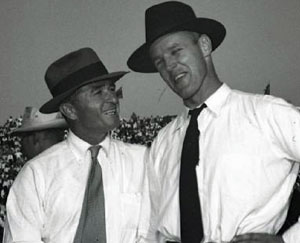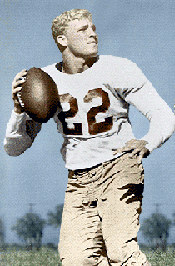- A touchdown scored on a play that started after the clock showed 0:00 at the end of the first half and no penalty was called on the previous play.
- Multiple delays because of bottles thrown on the field by spectators.
- A police car racing to the middle of the field as soon as the game ended to rescue the officials from enraged fans.
- Talk afterward of ending one of the nation's oldest rivalries.
The 1947 Shootout featured new head coaches on both sidelines.
|
|
- Oklahoma of the Big Six Conference defeated Detroit 24-20 in the Motor City, then downed Texas A&M in Norman 26-14.
- The Longhorns of the Southwest Conference dominated all three opponents: Texas Tech 33-0, Oregon on the road 38-13, and North Carolina at home 34-0.
- UT earned the #3 spot in the first Associated Press ranking of the season, right behind Notre Dame and Michigan. Oklahoma stood at #15.
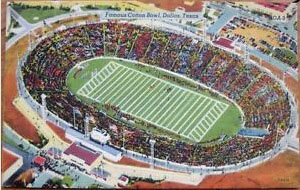 |
The 41st annual battle sold out six weeks in advance.
|
The quarterback duel promised excitement. Each cut a dashing figure and played with a flair that made teammates rally around them.
|
 Jack Mitchell |
- For example, 25-year-old Sooner E Jim Tyree lettered in 1941, '42, and '46. G Dee Andros, age 23, earned monograms in 1941 and '46.
- For the Longhorns, 23-year-old E Max Bumgartner lettered in '42 and '46. G Joe Magliolo, a week short of his 25th birthday as he prepared for the Red River Shootout, lettered in 1942 and '43 before returning to the varsity for the '47 season.
Magliolo's story is particularly interesting. He started at Texas in 1939 and, even though his parents didn't want him to play football, came out for spring practice from 1940-'42. He finally made the varsity for the 1942 season because so many players entered the military or transferred to schools that had military training programs that allowed them to play football. Playing blocking back in Bible's single wing offense, he became a co-captain for the '43 season and was drafted by the Chicago Cardinals in the 1944 NFL draft. But he spurned pro ball and went off to war, serving in the Navy for two years.

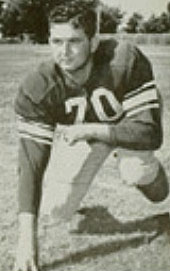
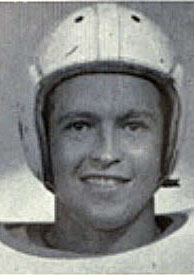
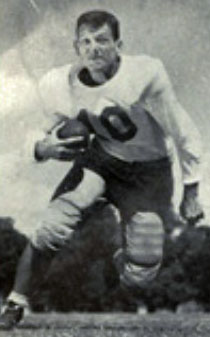
L-R: Jim Tyree, Dee Andros, Max Bumgardner, Jim Canady
- The speedy Longhorns had scored five TDs in each of their three previous games. OU assistant coach Dutch Fehring called Texas "the greatest collegiate team ever assembled" and predicted that if OU and TU both played well, "they will outscore us six touchdowns to two."
- Oklahoma pegged its hopes on its running attack, whose success would allow the Sooners to milk the clock and keep Layne & Company off the field.
- Even though the rules as relaxed during the war allowed free substitution, Wilkinson and his staff fielded a first unit and a second unit for both offense and defense.
Future OU All-American lineman Jim Owens recalled: "We played both ways. You blocked as well as tackled. Bud substituted by units. Usually, midway through the first quarter, the second team came in to relieve the starters. ... By keeping our troops fresh, we were able to keep the ball longer and thus wear down the defense."
- As the sun set Friday afternoon, Dallas police broke up log jams of traffic on downtown streets.
- Tickets were being hawked for as much as $45. End-zone seats were going for $20 and $25. A squadron of police moved into the hotel lobbies to enforce the city's anti-scalping ordinance. One youth selling tickets for $10 each was arrested and fined $50.
- In addition, a black market on hotel reservations was in operation with choice rooms going for as much as $75. To avoid the hubbub, the Longhorns spent the night in a Fort Worth hotel.
Dignitaries in town for the event included, on the Oklahoma side, U.S. Senator Elmer Thomas, former Governor Robert Kerr, and university president Dr. George Cross. Among the prominent Texans was Governor Beauford Jester.
| OKLAHOMA | Pos. | TEXAS | ||
| Jim Tyree | Sr | LE | Max Bumgardner | Sr |
| Homer Paine | Jr | LT | Richard Harris | Jr |
| Buddy Burris | Jr | LG | Joe Magliolo | Sr |
| John Rapacz | Jr | C | Joel Williams | Jr |
| Dee Andros | Sr | RG | Dan Wolfe | So |
| Wade Walker | So | RT | Ed Kelley | Jr |
| Robert Goad | So | RE | Dale Schwartzkopf | Jr |
| Jack Mitchell | Jr | QB | Bobby Layne | Sr |
| George Thomas | So | LH | Byron Gillory | Jr |
| Charles Sarratt | Jr | RH | Randall Clay | So |
| Edward Kreick | Jr | FB | Tom Landry | Jr |
.jpg)
Action early in the game: White jerseys Texas, Dark Oklahoma
(University of Oklahoma Sooner Yearbook Class of 1948)
- The Sooners, surprising the Longhorns by employing an eight-man defensive line, stopped UT on their first possession. But after Oklahoma couldn't move on their turn with the ball, Texas got on the board on their second possession. Layne rifled a 39y pass that Jim Canady took over his shoulder with S Darrell Royal all over him at the OU 25. Several runs by Canady and a beautiful catch by Max Bumgardner on a short pass put the ball on the 13. From there, Byron Gillory took a Statue of Liberty handoff from Layne and skirted left end into the end zone. Frank Guess booted the PAT. Texas 7 Oklahoma 0
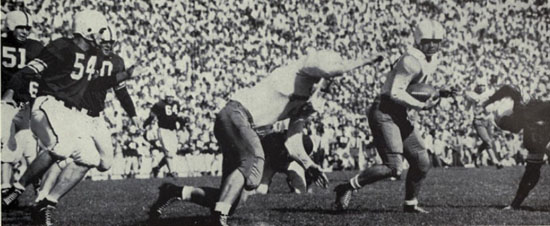
Byron Gillory takes the Statue of Liberty handoff from Bobby Layne for Texas's first TD.


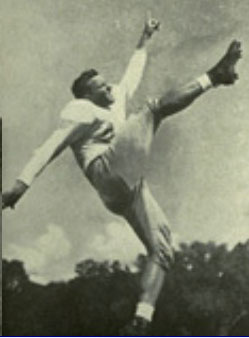
L-R: Darrell Royal, Charles Sarratt, Frank Guess
- Texas was right back in business on the first play after the kickoff when G Joe Magliolo picked up Mitchell's fumble on the OU 25. But the Longhorns went backward, and Landry punted over the goal.
On the Texas sideline, Coach Blair Cherry sat during the game chewing on grass stems. Players said that Blair not only chewed the grass all during a game but also swallowed it.
- Mitchell rebounded and led the Sooners 60y on his own thrusts plus those of Charlie Sarratt and George Brewer over Texas's left side. But two penalties, offsides and roughing, halted the march.
- On their next possession, the Sooners picked up where they left off, going 47y in nine plays behind the same three backs. Mitchell ran it in from the 3. Royal booted the point to tie the score 7-7 with 3:45 left in the half.
- In the final minutes, the Longhorns started a march from their 42. Behind Layne's timely passes and runs by Tom Landry, Canady, and Gillory, the Longhorns reached the three after a 22y pass from Layne to Landry, who lateralled to Gillory for the last 5y. Less than 30 seconds remained in the half.
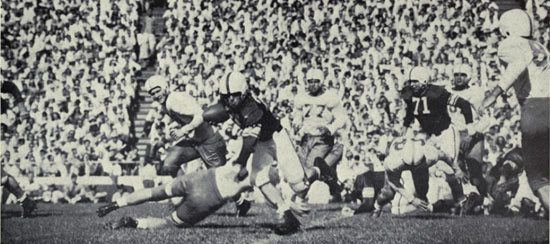
Jack Mitchell makes one of his many dashed into the Texas secondary.
(University ofTexas Cactus Yearbook, Class of 1948)
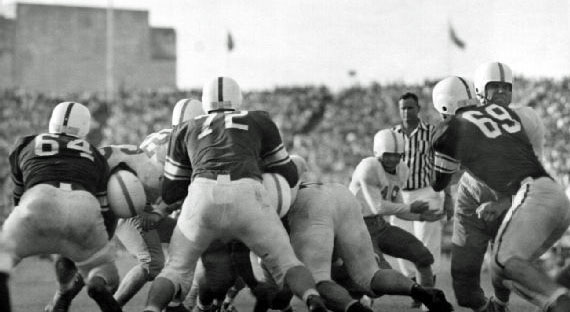
Referee Jack Sisco in background as Texas attacks the Oklahoma goal line. (University of Texas)
--Randall Clay banged into the line but gained only a yard.
--Clay tried again, and Referee Jack Sisco, head of the Southwest Conference officiating crew, threw his hands in the air signalling touchdown. However, when players were unpiled, it was obvious to everyone that Clay was short of the goal line. The clock ran out amid the confusion.
--Texas claimed they asked for a timeout before 0:00. Sisco granted it. Confused, the clock operator put one second back on the clock. Oklahoma fans screamed that the half was over.
Years later, Wilkinson said, "If I had been an experienced coach, I would have taken our team off the field when the clock ran out."
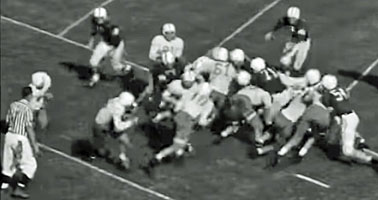
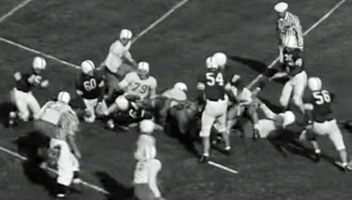
Layne hands to Canady (10), who fumbles as he is about to plunge into the end zone.
The ball squirts back toward Layne (22).
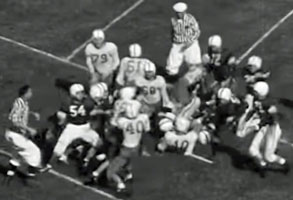

Layne picks up the ball and laterals to Clay (16), who sets sail for the goal line.
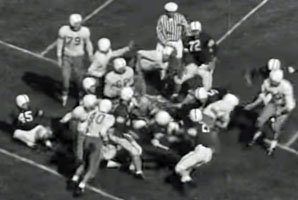
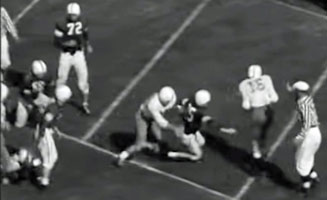
Clay bursts past two tacklers into the end zone.
- Midway through the third quarter, a Darrell Royal punt return to the 25 was called back and the ball placed on the 1' line thanks to a "ticky-tack" clipping penalty, bringing more howls from the OU fans. Sarratt punted out only to the 33, Gillory returning to the 23. Texas took advantage of the short field to increase its lead. Layne hit Bumgardner to the 10, then Canady carried the ball twice in a row, going into the end zone on the second shot as the quarter ended. Texas 21 Oklahoma 7.
OU answered back on the first play after the kickoff. HB George Thomas ran the ball to his 26, then tried to lateral to Mitchell, trailing on the right. Jack caught the ball on his fingertips and roared down the field untouched to complete the 72y touchdown. Dave Wallace kicked the extra point. Texas 21 Oklahoma 14
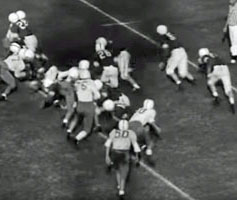
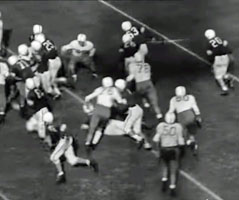
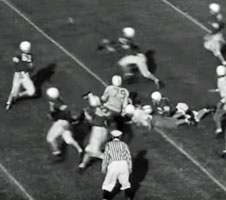
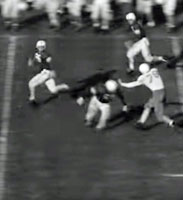
Thomas laterals to Mitchell, who runs for a TD.
- The Longhorns responded with an 84y, 15-play drive that was not exempt from controversy. Showing his ball-handling skill, Layne gave the pigskin to Canady multiple times to move into OU territory at the 38. Royal intercepted Layne's pass, giving the Sooners a chance to tie the score. But Sisco flagged OU lineman Stanley West for roughing the passer, nullifying the interception and putting the ball on the 23.
Oklahoma G Buddy Burris recalled: "West and I rushed him but I was in front and hit [Layne] just as he threw the ball. But I hit him clean."Given a second chance, Layne threw to Peppy Blount for nine, then handed to Canady for another nine. Clay did the honors, bouncing off the big OU line into the end zone. Texas 28 Oklahoma 14OU fans erupted again because they thought Clay's forward progress had clearly been stopped at the one. They showered the field with bottles, flasks, and cushions, halting the game as players moved to the middle of the field to get out of range. Wilkinson and the Oklahoma cheerleaders urged the fans to stop - to no avail. One bottle conked a cheerleader in the head. Quick-witted Texas cheerleaders began waving white handkerchiefs, which inspired 10,000 or so Texas fans to join in so that a great part of the big stadium was a waving sea of white. The barrage of missiles stopped only when the irate fans ran out of ammunition. Cheerleaders from both sides cleaned up the debris.With only two minutes left, Layne hustled in after Texas recovered a fumble on the Sooner 44. The Blond Bomber fired a 23y pass into the end zone to reserve E George McCall to end the scoring with 0:45 on the clock. Guess's fifth PAT try was blocked. Texas 34 Oklahoma 14One of Layne's receivers described his passing style this way: "I can't say he was a pure passer because his spirals weren't tight. He was a finesse passer - his passes were easy to catch."

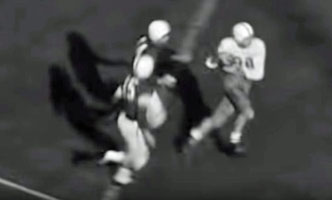
Layne fires TD pass to George McCall.
FINAL SCORE: TEXAS 34 OKLAHOMA 14
Texas gained 177y on the ground and 129 passing while Oklahoma's grinding attack produced 263y but only seven through the air.
Postgame
- The two teams shook hands in the middle of the field as more bottles rained from the stands. The Oklahoma cheerleaders tried in vain to stop the onslaught before joining their Texas counterparts in clearing the debris off the field. Numerous fist fights broke out in the stands. Longhorns fans in the stands booed what their opponents were doing.
Darrell Royal put his helmet on the head of his wife Edith and hustled her off the field into the tunnel. Even WWII vets were scared. Tom Landry, future Hall of Fame coach of the Dallas Cowboys: "A lot of us were war veterans. But I guarantee you we were scared."
- Meanwhile, several hundred Oklahoma fans jumped onto the field and made a beeline for the officials. But the Dallas police department, abetted by Texas Rangers, was ready. A phalanx of officers surrounded the men in striped shirts and whacked fans with their nightsticks until the refs could be whisked off in the police car.
OU lineman Merle Dinkens recalled: "They would have killed him if they could have gotten to him." Supposedly one fan did reach Sisco, but the former football star decked him with a single punch. "They were beating on the on the windows of the car while it left the field," recalled OU HB Tommy Gray. As the car drove slowly away, rioters yelled, "Let's turn it over!"
Umpire John Waldorf recalled: "I didn't get alarmed until some little guy knocked a cop off the fender of the police car with a bottle."
Bottled drinks would never again be sold in the Cotton Bowl.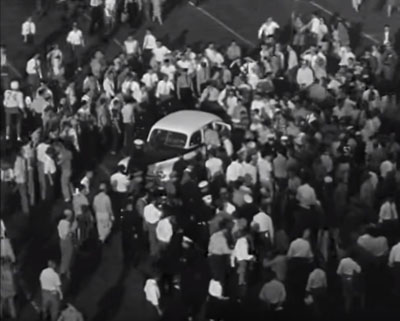
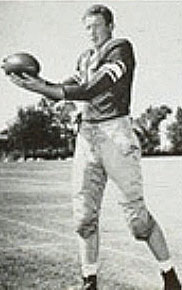
L: Fans at midfield around the police car that rescued the officials. R: Merle Dinkins - Meanwhile, fights broke out in the stands between UT and OU followers.
- Both bands played on the field. By the time they marched off, the brawling was confined to fans outside the student cheering sections.
- All evening, irate Sooners rampaged through downtown Dallas, smashing store windows and hurling furniture out of hotel rooms. Several innocent bystanders were injured.
The game remained a topic of conversation even after the teams returned to their campuses.
- Wilkinson the next day: "I was very disappointed at this demonstration by our fans. The Texas-Oklahoma football series is too fine a thing and has been too cleanly waged through the years to be spoiled by the bad manners of the crowd or by bad feeling of any kind. The game was very cleanly fought and the feeling between the Texas and Oklahoma players was very good all through the game. It is too bad spectators couldn't have reflected the fine behavior of the two games."
- However, Sunday night more than 1,000 OU students, led by the Ruf-Neks, the Men's Pep Club, hanged a dummy labeled "Jack Sisco" on a tree in front of the Administration Building on the campus. Someone ran off with the "body" before it could be burned in effigy. The next night, a crowd of 3,000 gathered in the campus parking lot and burned a new dummy while they chanted, "Jack Sisco's body lies a-moldering in the grave."
- "We got Siscoed" became a new way for Oklahomans to say, "We got screwed."
Years later, Sisco traveled to Shawnee OK for a luncheon. OU lineman Merle Dinkins was there. "Everyone there wanted to see if I would knock the hell out of him," recalled Dinkins. "I just looked at him and said, 'It's a wonder you didn't get killed coming up this way.'"
The tumultuous game led to talk of cancelling the 41-year-old series or at least changing the venue.
- Dr. Cross, president of Oklahoma, had stated a month before the game that it should be played on a home-and-home basis. His reason was the inadequacy of hotel rooms and tickets in Dallas. Although he had to miss the game because of a death in the family, he now reiterated that contention. "After the disorders of the weekend," he said, "I don't see how we can go back to Dallas now."
- An OU student petition to take the game out of Dallas gained some 3,000 signees. The Alumni Association scheduled a meeting at which it would take a stand on the matter.
- Texas AD Dana Bible urged everyone to "just keep cool, calm, and collected." Bible rejected Cross's proposal to alternate the game at the two campuses. "We will play either Oklahoma or some other top college eleven at the Cotton Bowl." He cited the fact that the game almost always produced more revenue for the competing schools than any other game for either. Each university received $41,404 as its share of the gate for the 1947 game.
- Naturally, Dallas officials wanted to continue the annual contest in their city. R. L. Thornton, president of the Texas State Fair, sponsor of the event, said, "We like the people of the state of Oklahoma, and we think that Texas and Oklahoma have much in common as the leaders of the Southwest. The annual contest ... should continue for the progress and betterment of the Great Southwest."
- Complicating talk of change was the fact that the two schools had signed a contract that required the game to be played in Dallas through 1952.
Follow-up
- The Longhorns finished the season 9-1 and ranked #5. The only loss, to SMU 14-13, cost Texas the SWC championship. As a consolation, UT accepted an invitation to the Sugar Bowl where they defeated #6 Alabama 27-7.
- Oklahoma ended Wilkinson's first season 7-2-1, good enough to tie for first with Kansas in the Big 6. The two teams were co-champs since they tied in their face-to-face meeting.
- Wilkinson quickly built one of the most dominant dynasties in college football history. The Sooners won the next three games against Texas, then after a loss, reeled off six more in a row.
- As we know, the Red River Showdown is still played in Dallas to this day.
References: Big Eight Football: The Story, the Stars, the Stats of America's Toughest Conference,
John D. McCallum (1979)
College Football's Most Memorable Games, 1913 through 1990: The Stories of 54 History-Making Contests, Fred Eisenhammer and Eric B. Sondheimer (1992)
I Love Oklahoma, I Hate Texas, Jake Trotter (2012)
"The wild, bottle-throwing, badly officiated 1947 OU-Texas game," Jake Trotter, www.espn.com (2017)
"Let's Hope This Year's TX-OU Game Doesn't Repeat the 1947 Game," Texas Monthly (Oct. 13, 2017)
1921: Centre @ Harvard
1924: Michigan @ Illinois
1929: Rose Bowl
1939: Texas Tech @ Centenary
1940: Bears @ Redskins
1941: Sugar Bowl
1941: Willamette @ Hawaii
1964: Alabama @ Georgia Tech
1947: Eagles @ Cardinals
1953: Iowa @ Notre Dame
1959: Oklahoma @ Northwestern
1966: Notre Dame @ Michigan State
1967: Ice Bowl (Dallas @ Green Bay)
1971: Nebraska @ Oklahoma
Memorable Games Archives - III
1967: Unlikely Hero (Super Bowl I)
1968: "Harvard Beats Yale 29-29"
1969: Believe in Bo
(Ohio State @ Michigan)
1974: "Who Won the Damn Game?" (Ohio State @ Michigan State)
1979: "You Shoulda Passed" (Sugar Bowl)
1980: Revenge Is Sweet (Kentucky @ Tulane)
1985: Greatest Finish No One Knows About (Principia @ Illlinois College)
1982: Kellen Gives His All (Chargers @ Dolphins)
1982: The Dolphins Wuz Robbed (Dolphins @ Patriots)
1984: No Tie for Tom (Orange Bowl)
1985: Let Sleeping Beavers Lie (Oregon State @ Washington)
1993: "Game of the Century" a Week Later (Boston College @ Notre Dame)
1997: Why It's Called "Foot"-ball (Nebraska @ Missouri
1948: The Snow Bowl (Cardinals @ Eagles)
1958: The Game That Made the NFL (Colts @ Giants)
1962: NFL Championship Game
1984: "We Don't Want No Stinkin' FG"
(Florida-Miami)
1929: Ernie's Record-Setting Day (Cardinals @ Bears)
1934: Gopher Deception (Minnesota @ Pitt)
1939: Why Didn't You Kick? (UCLA-USC)
1942: We Will Have Our Rose Bowl Trip!
1943: Sid Luckman Day (Bears @ Giants)
1952: Evy Surprises Woody (Ohio State @ Iowa)
1956: Unlikely Hero (Rose Bowl)
1963: Birth of Instant Replay (Army-Navy)
1965: A Day to Remember (49ers @ Bears)
Memorable Games Archives - VII
1942: East-West Shrine Game
1943: Del Monte Pre-Flight @ Pacific
1949: Notre Dame @ SMU
1950: The Snow Bowl (Michigan @ Ohio State)
1965: Chiefs @ Oilers
1969: Texas @ Arkansas
1970: Oregon @ UCLA
1972: Auburn vs Alabama
1984: Holiday Bowl
1986: Auburn @ Florida

